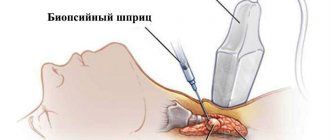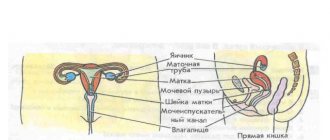When is it prescribed?
The pelvic organs are the bladder, in women – the uterus with appendages and cervix, as well as the ovaries, in men – the seminal vesicles and cords, and the prostate. The health of these organs largely depends on the quality of their blood supply . Any failure in the blood supply system is a consequence of any pathological changes, so it is important to detect it in time.
Women
For women who are not pregnant, the indications for the procedure are:
- cycle disruption;
- pain in the lower abdomen;
- absence of pregnancy within a year of sexual activity without contraception;
- repeated cases of miscarriage or miscarriages;
- detection of a tumor in the bladder or uterus;
- change in the thickness of the walls of the pelvic organs;
- problems with urination.
For pregnant women, duplex scanning of blood vessels is indicated:
- during pregnancy with twins or triplets;
- when the fetus is delayed in development;
- with rapid weight gain by the baby;
- as part of screening examinations (preferably at 20-25 weeks and mandatory at 30-32 weeks);
- in case of Rhesus conflict;
- if the baby is in the wrong position on the eve of birth.
It is important for a pregnant woman to undergo an ultrasound scan if she has diseases that provoke vascular pathologies , such as diabetes, hypertension, liver and kidney diseases.
For men
For male patients, such a study is relevant if the following pathologies are identified:
- infertility;
- changes in the structure of the testicles (compaction, decrease or increase in size);
- erectile disfunction;
- prostate diseases.
What is Doppler ultrasound?
Doppler is a device that measures sound waves. They are reflected from moving objects, which is very useful for examination if vascular disorders are suspected. The same method is used for diagnosis during pregnancy.
The processed information is transmitted to the monitor in the form of a picture or graph, which is studied by a specialist. Based on the data obtained, it is possible to accurately determine which and exactly where blood flow disturbances occur. Using Doppler ultrasound, the specialist determines:
- presence of blockages in blood vessels;
- movement of blood flow;
- structure of blood vessels;
- flow direction.
Additionally, using pelvic ultrasound, you can understand what the diameter of the vessels is.
What are they watching?
Scanning of blood vessels, both duplex and triplex, allows a detailed assessment of the condition:
- vessels of the prostate gland and its plexus (in men);
- uterine, ovarian and endometrial vessels, as well as spiral arteries (in women);
- arcuate and iliac veins and arteries (in all categories of patients).
Ultrasound examination plays a key role in assessing the condition of blood vessels, their patency and other significant indicators of blood flow.
Doppler in reproduction
As you already know, the collection of eggs in the IVF program in women is carried out by puncture of the vagina, and one of the serious complications is bleeding after puncture. It is the presence of the Doppler function on the sensor with which the puncture is performed that is the doctor’s insurance to avoid getting into the pelvic vessels.
For pregnancy to occur, at least 2 conditions are necessary - a high-quality embryo and a good endometrium. Exactly 20% of IVF failures are due to poor endometrial condition. Doppler testing of the uterine vessels on days 20-22 of the menstrual cycle, a qualitative assessment of the data obtained allows the doctor to identify endometrial pathology and assess the possibility of endometrium for implantation.
When do they do it?
Men can sign up for Doppler measurements at any time, but for women there are certain restrictions.
To establish the causes of vascular pathologies, especially if they are associated with venous stagnation, it is best to go to the doctor in the second half of the menstrual cycle , approximately 7 days before the expected menstruation.
The fact is that during this period the woman’s reproductive organs are filled with blood as much as possible.
For this reason, vascular pathologies are most clearly visible.
Examination in children
Ultrasound with Doppler is prescribed to babies at the age of 1 month to identify disorders associated with blood supply to the brain. Usually this procedure is carried out in the maternity hospital. There is no need to re-examine if no problems were found during the first examination.
Indications for ultrasound examination for children:
- prolonged headaches;
- poor sleep;
- dizziness;
- causeless tearfulness;
- restlessness and overexcitability;
- delayed speech development;
- memory and school performance disorders;
- fast fatiguability;
- vascular pathology;
- diabetes;
- other diseases associated with impaired blood circulation in the brain.
Children tolerate Doppler sonography well, since it is a painless research method that is performed only on the surface of the skin without penetration.
How do they do it?
There are two types of ultrasound examination: transabdominal and transvaginal. Which one to prescribe to a particular patient will be decided by the doctor, based on the patient’s complaints and indications for the study .
Transabdominal ultrasound is performed through the abdominal wall, meaning the probe is in contact with the patient's abdomen. Transvaginal ultrasound is used to examine women and is indispensable if vascular pathologies are detected in the lower abdomen. It is this type of diagnosis that will make it possible to examine all the features of blood vessels, both healthy and pathologically dilated.
To establish in detail all the features of the pelvic vessels, doctors use:
- Duplex scanning - makes it possible to find out the size of veins and arteries, the direction of blood flow and the capacity of the vessel.
- Triplex or color ultrasound - differs in color image on the monitor. The directions and speeds of movement of different blood flows are marked on the screen in different colors, this allows you to quickly assess their characteristics and compliance with standards.
All presented methods are based on the ability of an object in motion to reflect sound waves. The advantages of color circulation and triplex scanning are their speed, painlessness and safety (therefore, there are practically no contraindications to the procedures).
To examine the blood vessels, the patient needs to lie down on a trestle bed and take the position that the doctor will tell you. It will depend on how the ultrasound is performed: transrectally (through the anus, performed for men with prostate pathologies), transvaginally (by inserting a sensor into the vagina of women) or transabdominally (through the anterior wall of the peritoneum). The procedure lasts on average half an hour.
The procedure and possible complications
The procedure is carried out in the ultrasound room of the antenatal clinic or in a hospital setting. It is advisable to carry out this examination on an empty stomach.
For the transabdominal diagnostic option, you need to lower your trousers or skirt and lie down on the couch near the ultrasound machine.
With the transvaginal option, it is necessary to completely expose the lower part of the body and lie on the couch with your legs bent at the knees and spread to the sides. Or sit in a gynecological chair.
Best materials of the month
- Why you can't go on a diet on your own
- 21 tips on how to avoid buying stale food
- How to keep vegetables and fruits fresh: simple tricks
- How to curb your sweet cravings: 7 unexpected products
- Scientists say youth can be extended
The sensor is lubricated with a special gel, which promotes tighter contact between the device and the skin and smooth sliding of the meter. During diagnosis, the device modes alternately change, assessing the state of blood flow and soft tissues. Sometimes the examination is accompanied by some noise, which characterizes the sound of blood transporting through the vessels. The duration of this procedure ranges from ten minutes to half an hour. After completing the diagnosis, you need to wipe off any remaining gel and get dressed. The results of the duplex scan are assessed and interpreted by a gynecologist. Based on this study, the presence of pathology is determined and the necessary treatment is prescribed.
Decoding
Based on the results of the procedure, the diagnostician issues a conclusion, which will contain detailed ultrasound results, deciphered in advance.
Important! The conclusion should include information about blood flow in the veins and arteries, as well as the condition of the pelvic organs.
The functioning and characteristics of the vessels make it possible to find out the condition of the organ and evaluate the effectiveness of the treatment methods performed. That is why ultrasound examination is not only a diagnostic procedure, but also plays an important role directly in the treatment process.
Preparation for the procedure
No specific preparation is required for ultrasound of the pelvic organs with or without CD. To avoid false scan results, you should not smoke 8 hours before diagnosis. It is not recommended to take any drinks that affect vascular tone: coffee, alcohol, energy drinks, strong tea, various extracts of exotic fruits.
In rare cases, experts recommend not eating or drinking liquids if a transrectal or vaginal examination is planned. A full bowel or bladder can worsen the ultrasound result and prevent it from being fully performed.
Pathologies
Using ultrasound combined with vascular scanning, you can find out about:
- the onset of atherosclerotic changes;
- the presence of blood clots, tumors and cysts;
- compression of the vessel;
And also diagnose in time:
- myomatous or space-occupying formations in the uterine cavity or on its walls;
- individual inflammatory processes in the ovaries and uterus;
- varicose veins of the pelvis;
- inflammation of the prostate gland (prostatitis and abscess);
- prostate adenoma (benign tumor);
- varicocele;
- oncological neoplasms;
- congenital pathologies of the development of organs or blood vessels.
Video 1. Pelvic varicose veins on ultrasound.
What can you see with Doppler?
On a special monitor, the gynecologist sees a color picture, it allows you to evaluate:
- Total blood flow through the uterine vessels.
- Blood flow through the umbilical cord.
- Condition of the placenta.
- Amount of water.
- Condition of the vessels and arteries of the uterus.
The doctor analyzes not only the blood flow, but also its outflow. Through large vessels, blood enters the organ, it leaves, taking with it decay products; it is important that this process is synchronized.
Disturbances in the process of blood outflow and inflow lead to certain consequences. A pregnant woman may experience:
- arterial hypertension;
- gestosis;
- risk of miscarriage.
Most often problems arise with blood pressure. It increases due to the fact that it is the outflow of blood that is disrupted; by normalizing it with the help of medications, severe complications can be avoided.
Preeclampsia occurs at the end of the 2nd and beginning of the 3rd trimester. It is considered a pathology and leads to various complications. If the pregnant woman’s condition is not corrected, then everything can end in disaster.
The threat of spontaneous miscarriage is most often diagnosed in the early stages. With timely treatment it can be eliminated.
The study helps eliminate the possibility of developing pathology and correct the condition of the pregnant patient in a timely manner. In some cases, it helps save the life of the child and maintain the pregnancy.
Additional Research
During preoperative preparation for surgery or in complex diagnostic cases, the doctor may additionally prescribe:
- phlebography of pelvic vessels;
- CT (computed tomography with contrast);
- MRI with contrast;
However, before any complex and expensive examination, a classic transvaginal ultrasound should be performed, which can be performed in any hospital in the country.
Cost of Doppler testing
The price of the procedure varies depending on the type of procedure (planned or emergency), the purpose of the procedure and the scope of tasks assigned to the specialist. If you feel the need for it, or it was prescribed to you according to indications, contact the New Life clinic to ensure comfort, accuracy and reliability of diagnosis.
Of course, the Doppler function is available in almost every modern ultrasound machine, however, there are not many specialists who can correctly interpret the data of this study.
Our specialists are constantly improving their work with ultrasound programs; our clinic has introduced a test - placental growth factor, where, in addition to a blood test, the blood flow of the vessels of the uterus and placenta is assessed and a conclusion is issued on the risk of developing preeclampsia in the next two weeks and until the end of pregnancy.
We strive to identify pathology and predict the development of complications as early as possible and choose the right treatment tactics. We are always glad to see you in our center!
Doppler norms and deviations during pregnancy
There is a whole table of indicators, it is kept by the gynecologist. When conducting a study, the computer analyzes the condition of the pregnant woman and her fetus and compares the data obtained with existing information.
The procedure helps to analyze 3 main indicators:
- SDO (Systole-diastolic ratio);
- IR (resistance index);
- PI (pulsation index).
All of them indicate how blood flows to the reproductive organ. The normal value varies within a certain range. A slight deviation from the norm is perceived as a sign of pathology, but it all depends on the specific situation.
Attention! If the blood flow in the umbilical cord is impaired, the child will lag behind in development. Lack of oxygen and nutrients will lead to consequences.
If the blood flow is disrupted, but the fetus is developing normally, you should simply normalize the blood flow to the organ, this will help avoid complications.
The procedure helps determine the condition of the fetal aorta. If the child has developmental anomalies, the mother will be notified about this.
It is advisable to carry out Doppler ultrasound in conjunction with a screening test. In this way it will be possible to obtain the maximum amount of information about the condition of the fetus and the presence of pathological changes in it.
Preparation and technique for performing the examination
Before going for an ultrasound scan of the uterine vessels, a pregnant woman must go through a simple preparation process. For two to three days before the scheduled examination, you should refrain from eating foods that cause gas formation. If an emergency examination is indicated, then the preparation stage is skipped.
Ultrasound diagnostics of the uterus, which has a lot of vessels, showing the process of blood circulation in the placenta, is performed through the anterior abdominal wall. The patient removes clothing from the area being examined and lies on her back. The abdomen is lubricated with gel and a special sensor is placed against it. Next comes the process of collecting information and printing the results.











